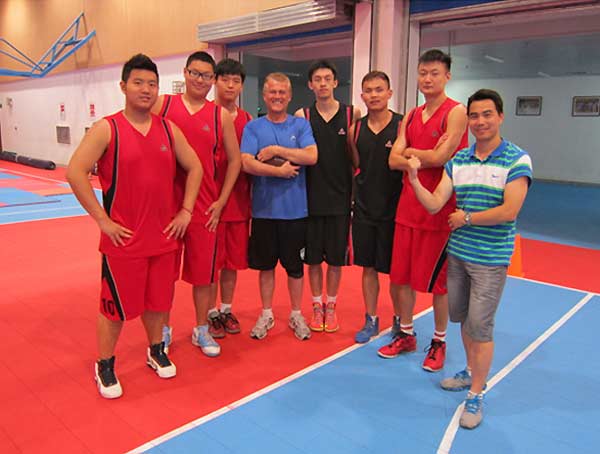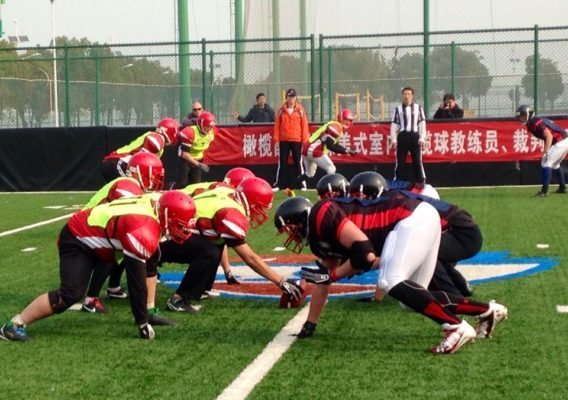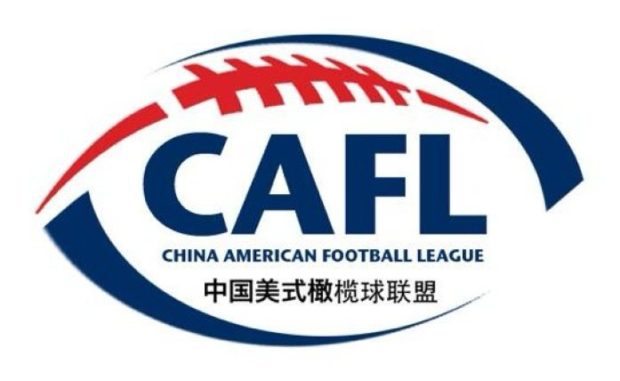“This is historic… we’re bringing American football to China.”
Written by William Hennelly
Lou Tilley (holding football, below right), media relations director for AFL Global, says he’s often asked if the Chinese are big enough to play American football. “Well, I’m 6’3, 215, take a look at the linemen I was coaching at Wuhan University!”

On September 18th, 2015, the China American Football League (CAFL) will kick off with eight teams on the mainland. The CAFL is affiliated with the Arena Football League (AFL), the purveyor of eight-men-a-side indoor football in the United States.
The new league is owned by business executive Martin Judge, founder, chairman and CEO of AFL Global and part owner of the AFL’s Philadelphia Soul. He is also the founder of the Judge Group, a professional services staffing company specializing in IT, based in West Conshohocken, Pennsylvania. The company also has a subsidiary in China.
Judge’s partners are Wu Hua, a journalist in China and president of Ganlan Media International (49 percent owned by AFL Global; Ganlan comes from the Chinese phrase ganlan qiu, or American football); and Ron Jaworski, former NFL quarterback and current ESPN football analyst. Jaworski is a majority owner of the Philadelphia Soul. Dick Vermeil, a Super Bowl-winning coach and a longtime friend of Judge’s, is also helping promote the new league.
Judge is ebullient when talking about his role as the father of American football in China. His bravado on the telephone and his appearances in videos are reminiscent of the late Oakland Raiders owner Al Davis.
“I even have my own stamp in China,” Judge said in a telephone interview with China Daily. “I’m not happy with that. I want a statue.”
A franchise in the CAFL will go for $10 million the first year, $20 million in the second, said Judge, who is confident the franchises will rise in value annually.
“We have 12 people who want them now,” he said. “Soccer franchises sell for $200 million to $400 million in China. There is no [American] football in China. Only us.”
Judge wouldn’t reveal who the potential owners are, but he said four will probably come from the US and four from China.

“San Francisco is like Asia,” he said, hinting as to where the American owners could come from. “I’m talking to all the owners in the NBA.”
Judge not only has brought pro football to China, he sponsored the first Chinese college football playoffs earlier this month. Six teams vied for the title.
Shandong Sport University defeated Hebei Institute of Physical Education, 46-42, on Oct 18 at the Chaoyang Sports Center in Beijing. The collegiate event gave players a chance to showcase their skills ahead of the CAFL draft next spring. Athletes will be eligible for the AFL upon graduation.
Judge said:
“We just had the first ever, ever, ever intercollegiate football games that six universities played against each other. They never played against each other in any sports. The last game had an “all-out brawl, a bench-clearing brawl. It’s just like the United States.”
Judge, who has worked the past few years to developing sport in China, also helped create the nation’s version of the National Collegiate Athletic Association (NCAA): the China Collegiate Athletic Association (CCAA).
The college games ironically were played outside, but under arena football rules. So why the switch to indoors for the pro league?
“The air pollution in China is bad,” Judge said. “They really don’t want to be outdoors. They love indoor sports: tennis, ping pong, badminton. There are 17 cities bigger than New York City in China, and every one of them has an arena!”
The 20-man teams are expected to be split evenly between Chinese and American players. The American players will come from the Arena Football League in the US. The Chinese players will likely come from the six college teams.
The average AFL player makes $832 a game in the US, but in China, players will be paid as much as $5,000 a game, “which is more money than they would ever make as a college graduate in China,” Judge said.
“I got the coaches; I got the general managers; the assistants; I got the doctors,” Judge said in reference to all the other AFL personnel who will participate in Chinese pro football. The AFL season in the US runs from March to August, so the schedules won’t conflict.
Foreigners working with the AFL are learning that Chinese men have the right football attributes.
“They’re big and strong,” Judge said. “They have big people and they can play football. They are competitive; they’re determined.” In the college championship, “the score changed 11 times. The boys on the losing team were all crying,” he said.
Sometimes, the players react as if they’re playing a different sport.
“They’re from a rugby world,” Judge said. “When that ball is dropped (on an incomplete pass), they still dive for it.”
David Niu, the president of AFL Global and a former Australian rugby player, also is optimistic about Chinese football players. “They’re quick. They are bigger than I thought they would be in terms of size and bulk. Fairly sizable college players crossed over from basketball, rugby, wrestling, track and field.”
They have to work on blocking and tackling (as do all football players), “but athletically you see some tremendous similarities between China’s athletes and any other athletes around the world,” Niu said.
The CAFL also has hired former NFL player Ed Wang to work on player development in China.
Wang (6-5, 315) was a four-year starter at offensive tackle for Virginia Tech and the first Chinese-American player drafted by the NFL. Wang’s parents were track-and-field athletes on China’s 1984 Olympic team.
He is “the face of our efforts over there”, Niu said.
“Ed Wang is my Yao Ming,” Judge said.
The Tianjin Pirates faced the Wuhan Nine-Headed Birds during the first China American Football League (CAFL) University Championships at the Chaoyang Sports Center in Beijing earlier this month.
The college games were used as a showcase for the nascent CAFL – the first American-style football professional league in China – which kicks off its inaugural season in September 2015.
The CAFL will be an indoor league featuring Chinese players and American players and rules from the Arena Football League in the United States.
The league’s timing could be fortuitous, as interest in American football in China is surging.
According to CAFL and National Football League (NFL) data, the number of urban Chinese ages 15-54 who consider themselves fans of American football grew from 1.6 million in 2010 to 14.1 million in 2013, or 462%.
“It is an exciting time for the sport in China,” Richard Young, managing director of Shanghai-based NFL China, said in an email to China Daily. “Our fan base has grown from a little over a million four years ago to over 14 million in 2014.”
TV viewership of NFL games in China (not counting the Super Bowl) went from 5.3 million in 2008 to 70 million in 2013, a gain of 1,320percent. The TV audience is projected to grow to 166 million by 2022. China’s extensive television and social media networks also help drive interest.
Young said that NFL China features live, delayed and highlight broadcasts on more than 20 platforms across China. The NFL also sponsors a 36-university flag football league, 28 on-ground events and a 13-city NFL truck tour.
“Every year we do more than what we did the year before, and we are starting to see the benefits, but we are just beginning,” Young said. “We are pleased to see the groundswell in interest in American football in China.” Young said the NFL was supportive of the CAFL’s efforts.
The new league is not without growing pains.
“The language difference is tough, especially with the referees,” Judge said. “I have all American referees. Probably our biggest challenge is going to be the referees. We have a lot of training to do.”
The CAFL hopes to have 14 teams in two conferences by 2016. The plan is for a North Conference made up of teams from Beijing, Tianjin, Qingdao, Nanjing, Shandong, Dalian and Shenyang. In the South, Shanghai, Guangzhou, Chengdu, Shenzhen, Wuhan, Xi’an and Chongqing will be represented.
After a 10-game regular season and playoffs, the advancing teams will play in the CAFL Arena Bowl on Dec 11, 2015. An all-star game is scheduled for Dec 18 in Macao.
“This is historic,” Judge said. “We’re bringing American football to China.”


